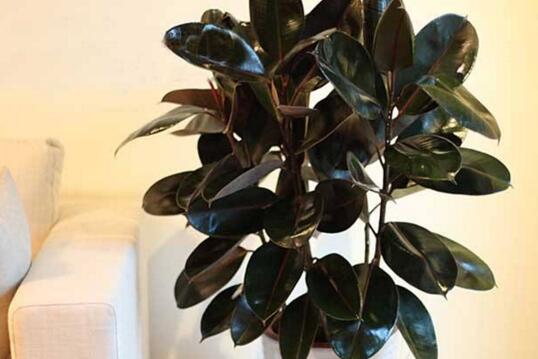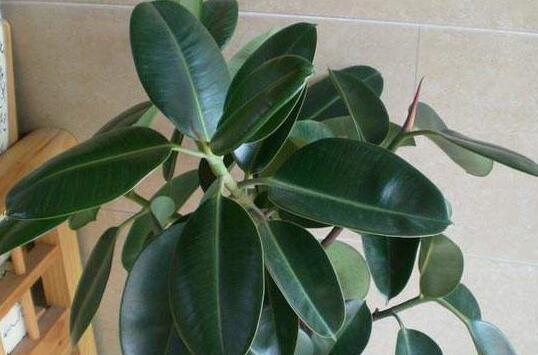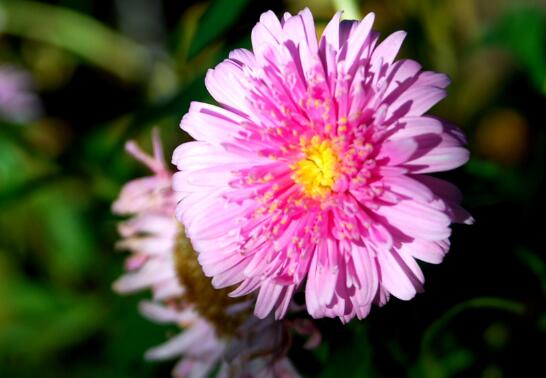Rubber tree winter maintenance methods, four tricks to make rubber trees safely through winter
Because the rubber tree is relatively weak in cold tolerance, how to maintain it in winter has become a worry for many flower friends. If it is not properly maintained, it is likely to make the leaves of the rubber tree fall off crazily, and it may also make it difficult to restore growth in the following spring. So how should it be maintained after winter? Let's take a look at the maintenance methods of rubber trees in winter.
Maintenance methods of rubber trees in winter
1. Temperature

There is no doubt that the most important thing in managing rubber trees in winter is the temperature. how many degrees should the temperature be above in order to make the rubber trees survive the winter smoothly? The answer is above 8 degrees. If the temperature in the area where florists live is often below 0 degrees in winter, you should pay attention to heat preservation by moving back indoors or covered with plastic film.
2. Light intensity
Many flower friends will move the rubber tree indoors in winter, which can control the temperature very well, but because the light intensity is different from that outside, we need to pay attention to increase the light reasonably at this time. In winter, it should be ensured that it can be exposed to direct or scattered light.
3. Watering strategy
Generally speaking, it is necessary to reduce the watering of rubber trees in winter, and it is more appropriate to make the soil drier. If the indoor air is relatively dry, you can spray some water around the plant. On the one hand, it can ensure that the soil is moist and the humidity is moderate.
4. Stop fertilization
Many animals go into dormancy in winter, and so will rubber trees, and their growth stagnates when the temperature is low, so the demand for fertilizer is not as high as in the growing season, so there is generally no need to apply fertilizer in winter. this point has been emphasized in rubber tree farming methods.
Matters needing attention in rubber tree culture in winter
1. Although the rubber tree can survive the winter smoothly when the temperature is above 8 degrees, for the sake of safety, the temperature had better be controlled above 10 degrees to avoid frostbite caused by the lower temperature at night.
2, when moving the rubber tree to indoor insulation, do not put it in a dark corner, do not think that it does not need sufficient light when it is dormant, otherwise it will make its green leaves turn yellow.
3. Although the rubber tree should be watered less in winter, it does not mean that it will not be watered once throughout the winter. When the temperature is relatively high, it can be watered appropriately, especially when it is about to be included in spring. Proper watering can quickly restore the growth of the rubber tree.
How to maintain flowers in White Dew's season
The management of fertilizer and water should be strengthened to bloom from autumn to Spring Festival.
In autumn, the amount of water for flowers should be controlled and fertilization should be stopped.
How to maintain flowers in White Dew season? In autumn, it is especially important to conserve flowers. In autumn, we should start to control the amount of water for flowers and plants and stop fertilizing, so as to avoid rotting roots and causing branches and leaves to grow and affect overwintering. Besides, it should be placed in a sunny place. Remember to prune flowers frequently in autumn. In this way, flowers can survive the winter better. Come and follow the editor to understand the attention of flower conservation in White Dew's season.
1. White Dew season Flower Conservation: light and timely some light-loving woody flowers that bloom in summer, such as jasmine, Fusang, Jiuli incense, etc., should still be placed in a place with plenty of sunshine, so that the plants can fully receive the light and promote the maturity of the current year's branches. so that it can survive the winter safely. Potted flowers such as rhododendron, magnolia, cyclamen, poinsettia and crab claw orchid that bloom before and after the Spring Festival should also be placed in a sunny place and receive full sunshine, otherwise the flowering period will be delayed or even will not bloom. Generally, foliage plants are more shady and can provide some light appropriately.
2. White Dew season flower maintenance: entering the house in time can be dealt with separately according to different varieties of flowers. Fusang, poinsettia, begonia, cyclamen, jasmine, colored leaf grass, tortoise back bamboo and other warm flowers and trees should be moved into the room when the temperature is 10 degrees Celsius; hanging orchids, asparagus, one-leaf orchids, goose palm wood, rubber trees, etc., should also be moved indoors when the temperature is 5 degrees Celsius.
3, White Dew season flower conservation: water and fertilizer timely and timely start to control the amount of flower watering, stop fertilization, so as to avoid water rotten roots, fertilizer causes branches and leaves to grow, affecting the overwintering. Flowers that bloom before and after the Spring Festival, such as cyclamen, orchid, crab claw orchid, rhododendron, etc., have passed the dormant period and began to enter the peak growing season, so the management of fertilizer and water should be strengthened from autumn to Spring Festival, and appropriate application of phosphorus and potash fertilizer can be added to facilitate the formation of flower buds. Start to control the amount of water for flowers in autumn, stop fertilizing, start to control the amount of water for flowers in autumn, stop fertilization
4. White Dew season Flower Conservation: pruning timely except for flowers that bloom in early spring, most flowers, such as jasmine, crape myrtle, pomegranate, can be trimmed and shaped in autumn, which can reduce the consumption of nutrients in winter and increase the number of potted flowers in the following year. When pruning, remove diseased branches, withered branches, over-dense branches, but only grow branches, laying a good foundation for potted flowers to survive the winter.
5, White Dew season flower conservation: breeding in time to enter the autumn temperature gradually lower, some biennial flowers, such as pansy, carnation, melon and leaf chrysanthemum, hollyhock, etc., is a good time to sow seeds. Pay attention to spraying water after sowing to keep the soil moist. There are some woody flowers suitable for cutting in autumn, such as rose, geranium, jasmine, etc., with a higher survival rate in autumn. Perennial root flowers that need ramets for dense growth, such as peony and peony, should be propagated in time. For flowers that bloom before and after the Spring Festival, such as Fengshou, tulips, Zhu Dinghong, etc., we should seize the time to put them on the pot.
How to ensure the safety of flowers through the winter? Common sense of taboos on growing flowers in winter
Winter is the least favorite season for flower lovers. The decrease of temperature and sunshine make it difficult for many flowers to survive the severe winter. How to ensure the safety of flowers through the winter? Different kinds of flowers have different growth habits, and different management measures should be taken to ensure their safe overwintering.
1. Cold protection and heat preservation
Evergreen flowers that like warmth or are still growing in winter can be placed near the south window to ensure more sunshine and higher temperature. Non-hardy evergreen woody flowers should not be placed near often open doors and windows to avoid cold wind attack and cause plants to be frozen. If the temperature at home is low, you can make some simple heat preservation facilities to help plants survive the winter.
(1) make the insulation cover in the pot and tie the iron wire into an arch ring bracket that is slightly larger than the crown of the flower, and then connect the plant to the pot cover with plastic film, so that the leaves are not attached to the film wall. Then, how many small pieces are stuck on the plastic film cover? Also, to facilitate ventilation and ventilation. If the weather is very cold, double-layer film cover can be used for heat preservation, and the heat preservation effect is remarkable. Milan, magnolia and jasmine are all suitable for longevity flowers as shown in the picture.
(2) use a larger flowerpot for thermal insulation, fill some thermal insulation materials or put soil in the pot, and embed the pot with flowers in the large flowerpot.
2. Humidification and dustproof
The indoor air is dry in winter, and flowers such as asparagus, orchid, gentleman orchid, Milan, camellia, tortoise back bamboo, calla and other flowers in a humid environment, such as dry leaves, dry edges, shedding and leaf color yellowing, must be artificially increased in air humidity.
① avoids putting potted flowers too close to the heater.
② often sprays branches and leaves with warm water close to room temperature. Spray water around noon on a sunny day (it is easy to freeze flowers in the evening); keep indoor air circulation while spraying water.
③ for wet orchids, magnolia, magnolia, rhododendron (photo), camellia, etc., can be covered with plastic film to increase and maintain air humidity, conducive to dust and cold protection.
④ mix 1 serving of beer with 2-5 times water, gently scrub the leaves of foliage plants with fine gauze, or spray the leaves on the front and back of the leaves to make the leaves dark green and bright.
3. Fertilizer and water management
In winter, most plants grow slowly or semi-dormant, and their nutrient absorption capacity decreases, so the supply of fertilizer and water should be reduced. Pot soil is not dry without watering, you can stop fertilizing or applying thin fertilizer. Water will cause rotten root death, thick fertilizer can easily cause fertilizer damage to death. Cactus plants should not be fertilized in winter.
4. Control temperature
Winter indoor temperature is generally 16-20 ℃, tropical and subtropical flowers should be controlled watering, otherwise it is easy to cause rotting root death. Temperate flowers can be managed normally.
The taboos for the maintenance of flowers in winter are as follows:
(1) avoid excessive indoor temperature
The temperature of dormant flowers should be controlled at 4-8 ℃, not more than 10 ℃. If the temperature is too high, it is disadvantageous to the growth of the next year. Such as Milan, Gardenia (Picture), Riley, Orange, Wintersweet, Fig, Pomegranate, Iron Stem Begonia, Honeysuckle, Yingchun, Chunlan, Cymbidium and so on.
(2) avoid excessive fertilizer and water.
Flowers need little fertilizer and water during the dormant period. Hibernating flowers do not need to be fertilized in winter, and fertilization may damage the roots of flowers.
(3) avoid air drying.
The dry environment in the north will affect the growth of flowers. Spraying water to the leaves and spraying water on the ground should be used to increase humidity. The flowers that need high air humidity are Camellia, rhododendron, orchid, hanging orchid, asparagus, Magnolia, Fusang, cyclamen, jasmine, rubber tree, tortoise back bamboo, Milan, Michelia, Haitong, cactus and so on.
(4) lack of light exposure
There must be at least 3 hours of light every day before flowers can thrive next year. Even woody flowers without leaves should see the sun and should not be kept in the dark for a long time.
The above is Huinong net Xiaobian collation about the winter maintenance of flowers, flower friends must study carefully, so that their own flowers safe through the winter.
- Prev

How to apply fertilizer to rubber trees, what is good to apply fertilizer to rubber trees / four correct fertilization methods
The growth speed of the rubber tree is closely related to the breeding method, and fertilization is an important link, which can make the plant more beautiful, the leaves more shiny and the color green. It can be said that good fertilization can maximize the role and efficacy of the rubber tree. So how do rubber trees fertilize? Let's take a look at the specific methods.
- Next

How to fertilize chrysanthemum, how to water / apply thin fertilizer / avoid stagnant water
Chrysanthemum morifolium is a kind of highly ornamental flower plant, and there are many people who raise it in our country, but if we want to raise it well, we need to pay attention to many places, such as fertilization and watering is one of the key points, so how to fertilize chrysanthemum? How do you water the chrysanthemum? Next, the editor will take you to learn about it.
Related
- Fuxing push coffee new agricultural production and marketing class: lack of small-scale processing plants
- Jujube rice field leisure farm deep ploughing Yilan for five years to create a space for organic food and play
- Nongyu Farm-A trial of organic papaya for brave women with advanced technology
- Four points for attention in the prevention and control of diseases and insect pests of edible fungi
- How to add nutrient solution to Edible Fungi
- Is there any good way to control edible fungus mites?
- Open Inoculation Technology of Edible Fungi
- Is there any clever way to use fertilizer for edible fungus in winter?
- What agents are used to kill the pathogens of edible fungi in the mushroom shed?
- Rapid drying of Edible Fungi

